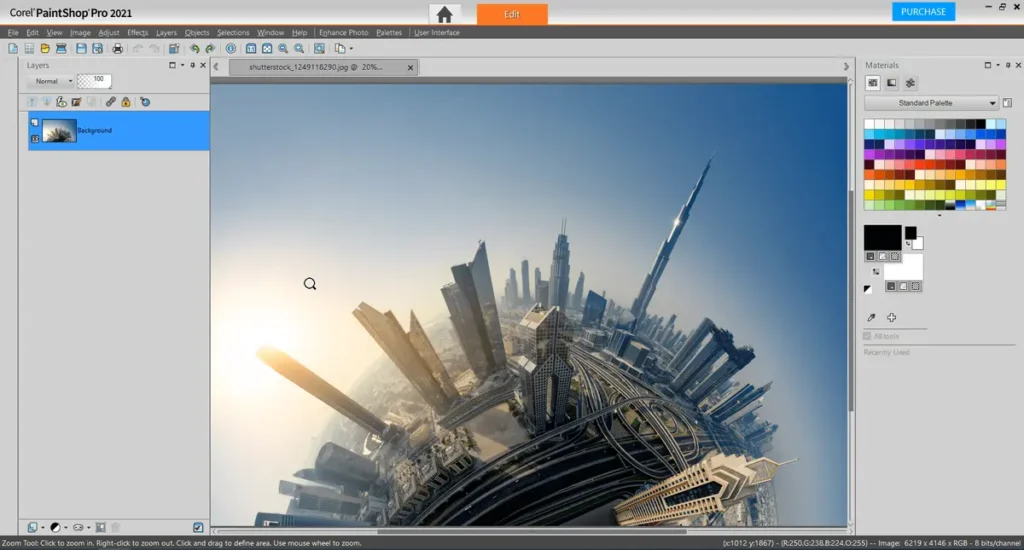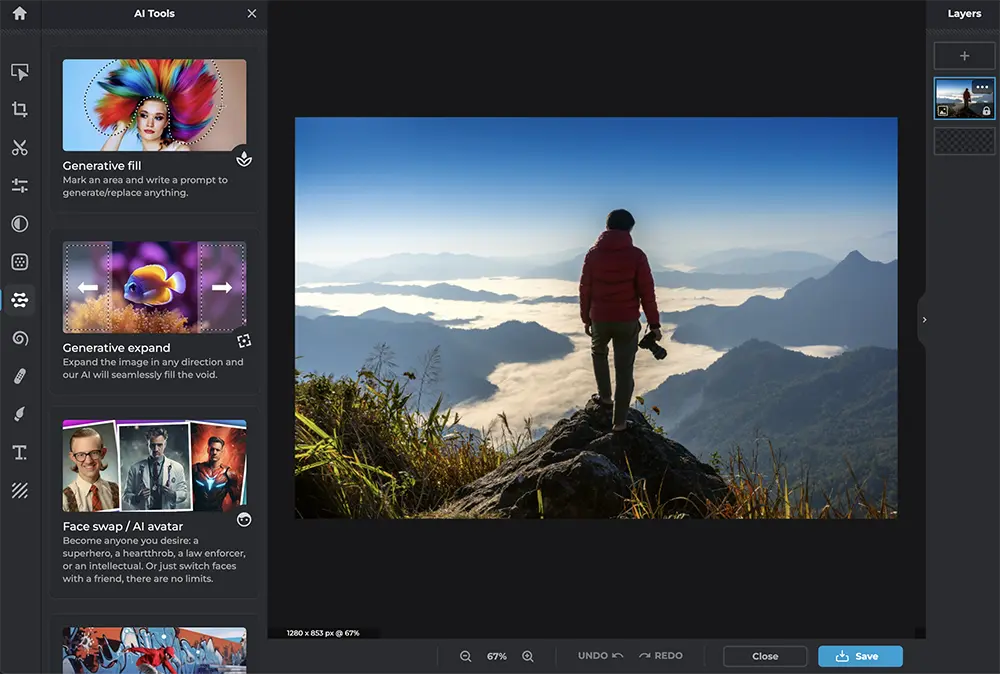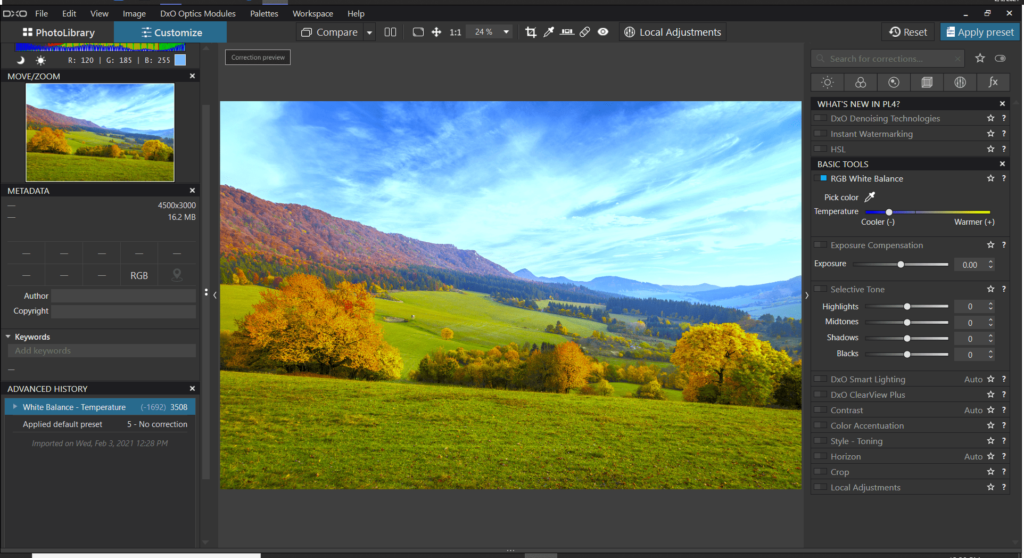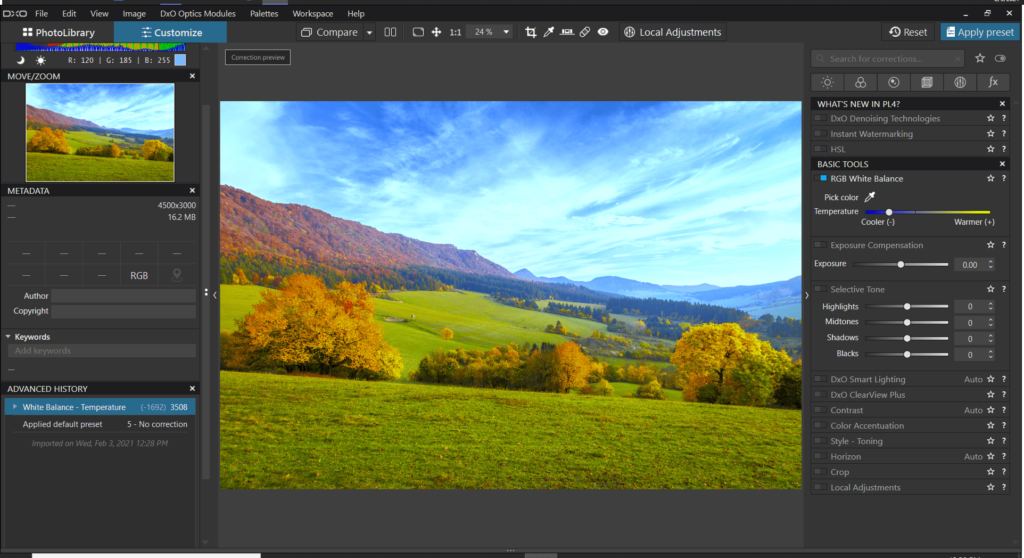The surge in photo-sharing platforms like Instagram has raised the bar for high-quality images. While it may seem that everyone is a professional photographer, the reality is that anyone can create visually striking photos. With the right photo editing software, even basic images can be transformed into masterpieces.
Selecting the ideal software can be daunting, especially for beginners. To simplify the process, we’ve analyzed the best photo editing programs based on key factors such as affordability, features, and user-friendliness. Our goal is to guide you toward the perfect tool to enhance your photos effortlessly. Continue reading to explore our top recommendations.
Our Top 3 Photo Editing Software for Beginners
PhotoDirector – Best Overall
PhotoDirector stands out as the top choice for beginners, offering an intuitive and sleek interface along with guided editing features. This comprehensive software covers all aspects of photo editing, from organization and design to sharing, printing, and editing. With its easy-to-use automatic, one-click tools, beginners can quickly enhance their photos, while manual adjustments are available for those seeking more control.
[Detailed Review >]

PaintShop Pro – Best for Learning Editing
PaintShop Pro by Corel earns a spot among the best photo editing software for beginners due to its wealth of learning resources. It offers a user-friendly environment with AI-powered features and Smart Selection tools that make automatic editing a breeze. These tools are perfect for those looking to improve their skills while easily enhancing their photos.

Luminar Neo – Best for AI Enhancements
Luminar Neo is a favorite among both beginners and experienced photographers, thanks to its robust AI-powered enhancement tools. This software stands out as one of the best options for beginners aiming to achieve professional-quality results with minimal effort, making it a top choice for effortless yet powerful photo editing.

Read More: AI Beard Filter: Find Your Perfect Beard Style Instantly
7 Best Photo Editing Software for Beginners
- PhotoDirector
- PaintShop Pro
- Luminar Neo
- PhotoPad
- Pixlr
- DxO PhotoLab
- Lightroom
PhotoDirector – Best Photo Editing Software for Beginners
Key Features
- Animated effects like Dispersion and Sparkle add a glittering touch to photos
- Automatic color effects, such as Color Replace and Color Splash
- AI Retouching tools for face, skin, and body enhancement
- AI Replace swaps out objects using a text prompt
- Compatibility: Windows, Mac
Beginner-Friendly Tools: 5/5
Price: Free
Premium subscription available for $3.75/month
PhotoDirector offers a comprehensive editing and organizational experience for beginners, hobbyists, and experts alike. Its user-friendly interface and powerful features, including AI tools, make it an ideal choice for newcomers to photo editing.
The software’s intuitive design ensures easy navigation, while AI-powered features like facial recognition and Smart Collections help organize content effortlessly. The adjustment sidebar provides simple sliders for color correction, resizing, and image repair, alongside advanced tools like Dehaze, Defringe, and Denoise. Localized effects ensure precision in every edit.
Beyond photo editing, PhotoDirector serves as a graphic design tool with templates, text designs, stickers, and access to over 130 million stock images and music tracks. Advanced users can explore layer editing with 27 blending modes, offering more creative freedom. It also supports a wide range of export options, including formats optimized for social media and print.
A highlight of PhotoDirector is its suite of AI tools—AI Image Creator, AI Scene Generator, AI Background Replacement, and AI Headshot generation—that allow users to make quick fixes, replace backgrounds, or even create professional headshots without the need for additional photoshoots.
Affordable and continuously updated, PhotoDirector offers a robust free version and a premium subscription for those looking for more advanced features. It empowers users to edit, create, and share content in ways they never thought possible.
Try the best photo editing software for beginners for free today through the link below.
PaintShop Pro – Best for beginners who want to learn photo editing and graphic design

Affordable One-Time Fee
Cons
- Clunky workflow
- AI tools lag behind those found in competing software
Key Features
- Built-in templates for collages, greeting cards, social media images, and more
- RAW, HDR, and 360-degree photo editing
- Content-aware tools such as SmartClone, Magic Move, and Magic Fill
- Compatibility: Windows
Beginner-Friendly Tools: 5/5
Price: $79.99
PaintShop Pro offers an affordable, user-friendly experience for beginners looking to delve into photo management and editing. With advanced features like 3D modeling, typography, and photo organization, it caters to users of all skill levels. Beginners can also take advantage of valuable resources like tutorial videos, a DiscoveryCenter, Learning Page, and the User Guide to get started.
For hands-on editing, PaintShop Pro offers a variety of automatic tools as well as manual options, such as the Selection tool for masking objects, the Magic Wand, Smart Selection Brush, Auto Selection, and Refine Brush. Features like batch processing and Scripts help save time and enhance productivity.
PaintShop Pro is often regarded as a more affordable and accessible alternative to Photoshop, offering a comprehensive suite of tools. However, it falls behind PhotoDirector in certain areas, particularly with less frequent updates (annually vs. monthly) and less advanced AI capabilities. PhotoDirector also benefits from a more streamlined interface and smoother workflow.
Luminar Neo – Best for AI image enhancements

Key Features
- Mask AI automatically selects architecture, water, sky, people, and more
- Generative AI tools like GenErase, GenExpand, and GenSwap
- Dodge and burn tools for lighting adjustments
- Compatibility: Windows, Mac
Beginner-Friendly Tools: 4.5/5
Price: $99/year for Explore, $119/year for Pro
Luminar Neo stands out with its powerful suite of AI tools, each equipped with an intuitive slider for easy enhancement adjustments. Features like Enhance AI, Relight AI, Atmosphere AI, and Sky AI enable quick, precise image improvements, including sky replacement with 35 available options.
The software’s beginner-friendly interface makes photo editing accessible, with automated tasks and smooth navigation across three primary modules: Catalog, Presets, and Edit. The Presets tab offers 120 filters, 50 image overlays, and 40 LUTs for creative customization, enhancing your photos with minimal effort.
While Luminar Neo excels in AI-driven enhancements and manual controls, its organizational tools fall short compared to competitors, lacking features like keyword tagging and facial recognition. Additionally, some AI tools showed occasional inconsistencies in testing. Despite these drawbacks, Luminar Neo’s responsive development team and fast, impactful editing make it a great choice for beginners.
PhotoPad – Best for quick edits

Key Features
- Automatically create embroidery patterns or paint-by-number from your image
- Retouch tools, including auto-fix, noise reduction, and portrait touch-ups
- Selection tools for applying regional effects
- Compatibility: Windows, Mac
Beginner-Friendly Tools: 4.5/5
Price: Free
Premium versions available for $60 (Home) and $70 (Pro)
PhotoPad from NCH Software is an excellent choice for beginners looking for quick and easy photo editing. Its revamped interface provides easy access to basic editing tools like crop, rotate, resize, and flip, along with automatic adjustments and sliders for retouching, color correction, and applying effects.
While simple to use, PhotoPad packs powerful features such as object removal, local effects, layer editing, HDR support, and graphic design tools for creating collages, calendars, cards, and more. Its robust color effects, including Color Boost and Color Dodge, allow for striking visual enhancements.
Regular updates ensure continuous improvements, including the addition of new features like the Remove Object tool. With a full photo workflow and strong sharing and printing capabilities, PhotoPad stands out as a top choice for beginners, offering more user-friendliness than competitors like DxO PhotoLab.
Pixlr – Best for easy graphic design with templates

Key Features
- Color Picker, Color Replace, and Sponge Color for regional color effects
- Frame tool automatically creates a frame around a selected area
- Dodge and Burn tools to lighten or darken specific areas
- Compatibility: Windows, Web Browser
Beginner-Friendly Tools: 4.4/5
Price: Free
Premium annual subscriptions available: $0.99/month for Plus, $4.90/month for Premium, and $9.91/month for Team
Pixlr is a versatile online photo editor also available for Windows, offering tailored interfaces for various tasks. It includes Pixlr Designer, featuring over 10,000 templates, design elements, and animation effects; Pixlr Editor for advanced editing; Pixlr Express with one-click AI tools; a Background Removal Tool; and a Batch Photo Editor for bulk editing.
Quick Links give easy access to popular features such as the AI Image Generator, Generative Expand, and Generative Fill. Pixlr simplifies layer editing for beginners and offers customizable drawing tools and one-click effects like Dispersion, Glitch, Liquify, and Mirror.
Despite frequent updates with trending features, Pixlr’s constant interface changes can frustrate users, and its generative AI tools lag behind those of competitors. However, it remains a user-friendly choice for both design and photo editing.
DXO PhotoLab – Best for noise reduction

Key Features
- Innovative ColorWheel for easier color manipulation
- Nik U Point for accurate local adjustments
- Lens and camera-based autocorrection
- Compatibility: Windows, Mac
Beginner-Friendly Tools: 4/5
Price: $139 for Essential, $229 for Elite
DxO PhotoLab is a top-tier photo editing software renowned for its advanced DeepPrime noise reduction, which utilizes AI to enhance RAW images during import, providing results equivalent to two ISO stops. While primarily aimed at professional photographers, it also ranks among the best for beginners due to its straightforward photo enhancements and organizational tools.
Beginners will appreciate the software’s one-click fixes for common issues such as noise, perspective, and color fade, enabling quick improvements. DxO frequently updates its Optics Modules to support the latest cameras and lenses, like the Sony A9 III, and continues to enhance usability with new presets, LUTs, and functionality.
While it excels in DSLR support, DxO PhotoLab does not support HEIC/HEIF file formats, which may be a drawback for iPhone photographers. Additionally, it lacks a full photo workflow solution, missing features like sharing, printing, and creation tools. Despite these limitations, DxO PhotoLab remains a powerful option for amateur photographers seeking high-quality RAW editing.
Lightroom – Best for lighting adjustments and night photography

Key Features
- Camera-based corrections
- Gradient and brush adjustments
- Streamlined photo management
- Compatibility: Windows, Mac
Beginner-Friendly Tools: 4/5
Price: $9.99/month
Lightroom is a top choice for beginners seeking image adjustments, offering intuitive sliders for exposure, contrast, highlights, and more. Its masking tools enable precise edits to specific colors or objects, and it excels at lighting adjustments, particularly for enhancing night shots while reducing noise.
The software stands out for its digital asset management capabilities, including automatic tagging by facial recognition, date, keyword, GPS location, camera model, and more. Lightroom also offers powerful healing tools and AI-powered presets to streamline the editing process. Its beginner-friendly interface is complemented by helpful resources like Lightroom Academy, which offers photography tutorials and a gallery showcasing “Before” and “After” images for inspiration.
Although Lightroom is excellent for improving image quality, it lacks layer editing and graphic design tools, limiting its functionality for those needs. Its high monthly fee may deter some beginners, placing it at #7 on our list despite its powerful adjustment tools and ease of use.
How to Choose the Best Photo Editing Software for Beginners
Choosing the best photo editing software for beginners requires considering a few key factors:
Ease of Use
Look for software with clear, intuitive menus and tools that are easy to understand. Many beginner-friendly programs offer Guided Edits, which help you learn how to use advanced tools. Additionally, AI-powered features are common in these tools, enabling one-click edits for precise results.
Features
Essential tools such as cropping, exposure adjustment, and color correction are fundamental for beginners. However, the best software for you depends on your editing goals. If you’re creating social media posts, YouTube thumbnails, or promotional flyers, software with graphic design tools like templates, stickers, and filters will be highly beneficial. For amateur photographers who need to manage their images, look for software with AI-powered tagging and photo organization features.
Budget
Free software is a great starting point for beginners, as many powerful options are available at no cost. Some are fully free, others offer limited-time trials of premium versions, while some provide basic features for free with the option to upgrade. Paid software often comes with more advanced features and performance, so it’s wise to test any program before committing to ensure it meets your needs.
How We Test the Best Photo Editing Software for Beginners
We test the best photo editing software for beginners using a variety of test photos with different lighting conditions, complexities, and resolutions. Here’s how we evaluate each program:
User Experience
We assess how easy it is to install the software and whether it requires a high-performance computer to run smoothly. The interface is tested for its intuitiveness and user-friendliness—can you easily locate the tools you need? We also evaluate how quickly the software loads and performs edits on various image sizes and formats.
Compatibility
We check whether the software supports commonly used file formats like RAW, JPEG, and PNG. Additionally, we look at its ability to export edits in different formats and sizes for various uses such as web or print.
Editing Tools
We test core editing tools like exposure, contrast, white balance, and saturation for precision and ease of use. We also use selection tools to ensure they are accurate and user-friendly. If the software includes advanced features like layers, masks, or HDR editing, we test their functionality and accessibility for beginners. Furthermore, we explore any AI-powered features such as object recognition, automatic adjustments, and generative AI tools to evaluate their accuracy and effectiveness.
What is the Best Photo Editing Software for Beginners?
Each of the best photo editing software options for beginners offers unique advantages to users. While all the programs we’ve highlighted are easy to use, some also provide advanced tools with guided edits that simplify the learning process for new users.
We believe our top pick, PhotoDirector, will appeal to the broadest range of users, regardless of their editing experience or budget. This all-in-one platform delivers a comprehensive suite of tools, frequent updates, and outstanding value. With one-click tools, manual adjustments, guided edits, layer editing, and graphic design features, PhotoDirector is designed to cater to both beginners and more experienced photographers. Its combination of photo management capabilities, advanced effects, and animated tools makes it an excellent choice for users at any skill level.
Try PhotoDirector today by downloading the free trial through the link below.
Frequently Asked Questions
What is the best photo editing software for beginners?
The best photo editing software for beginners depends on your needs, but PhotoDirector is highly recommended due to its easy-to-use interface, guided edits, and powerful AI tools. It offers a wide range of features and is perfect for both beginners and advanced users.
Is PhotoDirector free?
Yes, PhotoDirector offers a free version with essential photo editing tools. However, there is a premium version available that unlocks additional features such as more advanced AI tools and creative effects.
How easy is it to use PhotoDirector for beginners?
PhotoDirector is designed with beginners in mind. Its intuitive interface and guided edits make it easy to navigate, and its one-click tools provide quick solutions. Additionally, the software includes tutorials and resources to help users get up to speed.
Can I use PhotoDirector for social media posts and graphic design?
Absolutely! PhotoDirector includes graphic design tools such as templates, text designs, stickers, and over 130 million stock images. It’s perfect for creating eye-catching social media posts, flyers, and more.
Does PhotoDirector support RAW image editing?
Yes, PhotoDirector supports RAW image editing, making it a great option for photographers who want to get the most out of their images.
Is there a free trial for PhotoDirector?
Yes, PhotoDirector offers a free trial version so you can try the software before committing to a premium plan. Download the free trial and explore its features!
How does PhotoDirector compare to other photo editing software like Photoshop?
While PhotoDirector is more beginner-friendly than Photoshop, it still offers powerful tools and advanced features. Photoshop is ideal for professional photographers and designers, but PhotoDirector provides a great balance of ease of use and functionality, making it a better fit for many beginners.
Conclusion
Choosing the right photo editing software for beginners can make a world of difference in your creative journey. Whether you want to enhance your photography skills, create stunning social media posts, or explore graphic design, there are several great options available. PhotoDirector stands out as our top pick due to its combination of powerful tools, beginner-friendly interface, and continuous updates. It caters to users of all skill levels, offering one-click solutions, advanced AI tools, and graphic design features that allow you to create professional-quality images with ease.
For those who are just starting out, software like PaintShop Pro and Luminar Neo also offer excellent learning resources and AI-enhanced features, making them worth considering based on your specific needs. Always remember to explore free trials where available, so you can test out the software and find the perfect fit for your photo editing style and goals.
